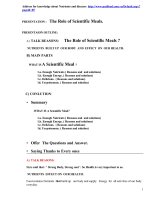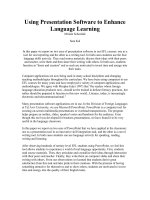Hr Audit - Jp Presentation
Bạn đang xem bản rút gọn của tài liệu. Xem và tải ngay bản đầy đủ của tài liệu tại đây (210.04 KB, 17 trang )
HR AUDIT
(An Early Evaluation System)
S.Jayaprakash., M.Sc (IT), PGD.HRM, DLL & AL
HR AUDIT - Definition
• The Human Resources (HR) Audit is a
process of examining policies,
procedures, documentation, systems,
and practices with respect to an
organization’s HR functions
• It means, a systematic assessment
of the strengths, limitations, and
developmental needs of HR
management in the context of
organizational performance
HR AUDIT - OBJECTIVES
• To analyze and improve the HR
functions in the organization.
• To expose the strengths and
weaknesses in the HR function, and
any issues need resolution.
• To evaluate the efficiency and
effectiveness of HR functions.
• To ensure whether the HR function
is on the right path to achieve and
helping company to achieve its goal /
objectives or not.
HR AUDIT - Scope
• Audit of all the HR function.
• Audit of managerial compliance of personnel
• Policies, Procedures and Legal provisions.
• Audit of corporate strategy regarding HR
• Planning, Staffing, IRs, Remuneration and other HR
activities.
• Audit of the HR climate on employee motivation,
morale and job satisfaction.
HR AUDIT - Benefits
•
To improve contribution of the HR function
to the achievement of our business
objectives.
• To develop the professionalism of our HR
people
• Reduce the HR cost
• Find out the problems and solve them
smoothly.
•Provides timely legal requirement.
•Sound Performance Appraisal Systems.
•Smooth adoption of the changing mindset.
HR AUDIT - Tools
•
•
•
•
Interview
Document Review
Questionnaire
Sampling
The Audit should be
• Proactive
• Reactive
• Informative
• Developmental
HR AUDIT - Nature
An HR audit is a tool for evaluating the personnel
activities of an organization. The audit may include
one division or an entire company. It gives feedback
about the HR functions to operating managers and HR
specialists. It also provides feedback about how well
managers are meeting their HR duties.
In short, the audit is an overall quality control check
on HR activities in a division or company and an
evaluation of how these activities support the
organization's strategy.
HR AUDIT - Approaches
Auditors may adopt any of the five approaches for the
purpose of evaluation:
• Comparative approach
• Outside authority approach
• Statistical approach
• Compliance approach
• Management by objective approach.
Contd..,
• In the comparative approach, the auditors identify
another company as the model. The results of their
organization are compared with those of the model
company.
• In the outside authority approach, the auditors use
standards set by an outside consultant as benchmark
for comparison of own results.
• In the statistical approach, statistical measures of
performance are developed based on the company’s
existing information.
Contd..,
• In the compliance approach, auditors review past
actions to determine if those activities comply with
legal requirements and company policies and
procedures.
• The MBO approach creates specific goals against
which performance can be measured. Then the audit
team researches HR by MBO.
Who should conduct the audit?
• The team that is responsible for
the audit should represent a crosssection of the organization’s staff,
including line staff, middle and
upper management, and those
responsible for HR functions. or you
may use an external consultant to
assist.
How it should be conducted?
• The audit process consists of a series of questions
covering the following primary components of the
HR function:
1. Roles and HR information systems (HRIS)
2. Recruitment
3. Documentation
4. Training and development
5. Compensation and benefits
6. Performance management system and evaluation
7. Termination and transition
8. Legal issues and personnel policies
9. Health / Welfare systems
10.Employee Relations and
11. Safety
Contd..,
• The main process is to collect information to
answer the HR audit questions in each of above
categories and all the relevant information.
• The focus is on how these activities and tasks
are actually performed in the organization.
• The process of getting information, in and of
itself, can be quite informative.
How are needed improvements
identified?
• Once information is gathered, the audit
team reviews each major section and notes
difference between paper and practice.
• This can then be compared to best practice
(what we should do to best support our
organization’s mission).
How is follow-up and correction
done?
• A work plan with a timeline, accountability, and
deliverables should be created after the team
reviews the completed audit and identifies
areas where improvement is needed.
• Follow-up and review should be a regular
management function, performed on an ongoing
basis.
Conclusion
The auditors always prepare and submit an audit
report to authority of the organization, which may be
clean / qualified. The clean report indicates the
appreciative of the department's function, but the
latter one represents the gaps in performance and
therefore contains remarks and remedial measures.
HR Audit is very much helpful to face the challenges
and to increase the potentiality of the HR personnel
in the organization.
WISHING YOU A LONG &
REWARDING CAREER !!!
Thank you



![[CEHV3] Ethical Hacking Workshop Presentation](https://media.store123doc.com/images/document/13/ly/za/medium_zas1367917374.jpg)





